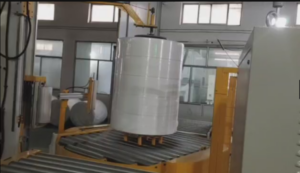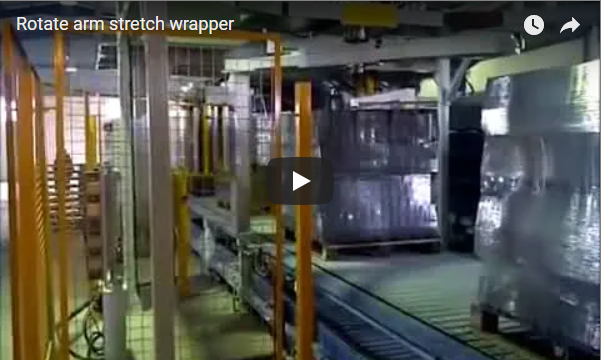Rotary Arm Stretch Wrappers: Operational Principles, Technical Specifications, and Integration for Pallet Wrapping
Rotary arm stretch wrappers represent a crucial technology in end-of-line packaging, particularly suited for handling unstable, heavy, or oversized loads. Unlike turntable wrappers where the pallet rotates, these machines keep the load stationary while a wrapping arm revolves around it, applying stretch film. This method offers distinct advantages in specific operational contexts. This article delves into the operational mechanics, key technical aspects, and integration potential of rotary arm stretch wrappers, aligning with an instructional focus.
1. Operating Principle Explained
The fundamental principle of a rotary arm stretch wrapper involves securing a palletised load while a rotating arm, equipped with a film carriage system, orbits the load.
- Load Stationarity: The pallet remains fixed on a conveyor or the floor. This is critical for loads that might shift or topple if subjected to the rotational forces of a turntable wrapper. Examples include tall, light, or irregularly stacked goods.
- Rotating Arm: The arm, driven by a robust motor and typically supported by a heavy-duty frame or overhead structure, carries the film dispensing system around the pallet.
- Film Carriage and Pre-stretch: The film carriage moves vertically along the arm's mast to ensure complete coverage of the load from bottom to top. Modern systems incorporate powered pre-stretch mechanisms (often achieving ratios of 150% to 300% or more), which stretch the film before application. This optimizes film consumption, enhances load containment force, and improves wrap consistency.
- Wrapping Cycle: A typical automatic cycle includes film attachment, pre-set number of bottom wraps, upward carriage travel with wrapping, pre-set number of top wraps, downward carriage travel with wrapping, and finally, a film cut and clamp/wipe system to complete the process securely.
2. Key Technical Specifications to Consider
When evaluating rotary arm stretch wrappers, several technical parameters are important:
- Maximum Load Size (L x W x H): Defines the dimensional limits of the pallets the machine can handle. Common ranges accommodate standard pallet footprints but can be customized for larger items.
- Maximum Load Weight: Specifies the weight capacity the supporting structure (if floor-mounted) or surrounding conveyor system must handle. The machine itself doesn't bear the load's weight directly during wrapping, unlike turntable models.
- Rotation Speed: Typically measured in rotations per minute (RPM), influencing the overall throughput (pallets per hour). Speeds often range from 12 to 30 RPM, depending on the model and load stability.
- Film Carriage Vertical Speed: Affects the wrap pattern density and cycle time.
- Pre-stretch System: Percentage of powered pre-stretch achievable. Higher percentages generally mean greater film efficiency.
- Control System: Usually PLC-based (Programmable Logic Controller) with an HMI (Human-Machine Interface) for setting parameters like wrap counts, tension, overlap, and diagnosing issues.
- Power Requirements: Voltage, phase, and power consumption details.
- Safety Features: Light curtains, safety fencing, emergency stops, and arm rotation sensors are critical standard components.

coil and roll stretch wrapping machine 3. Core Advantages and Application Areas
Rotary arm wrappers offer significant advantages in specific scenarios:
- Handling Unstable or Heavy Loads: This is their primary strength. Loads exceeding turntable weight limits (e.g., > 2000 kg) or those susceptible to shifting are ideal candidates.
- High Throughput Potential: While RPM might seem lower than some high-speed turntables, the elimination of start/stop inertia for heavy loads can contribute to overall line efficiency, especially in fully automated systems. Throughput can range from 30 to over 100 pallets per hour depending on the configuration and load height.
- Integration Flexibility: Designed inherently for pass-through operations, they integrate seamlessly with powered conveyor systems in automated production or distribution lines.
- Consistent Load Containment: Precise control over film tension and placement, combined with effective pre-stretching, ensures reliable load stabilization for transport.
- Optimized Film Usage: Advanced pre-stretch systems significantly reduce the amount of film consumed per pallet compared to manual wrapping or machines with lower/no pre-stretch capabilities.
Common industries utilizing rotary arm wrappers include beverage bottling, building materials, chemical manufacturing, large appliance production, and high-volume distribution centers.
4. Integration within Automated Packaging Lines
The design of rotary arm wrappers facilitates integration:
- Conveyor Connectivity: Units are typically installed inline with roller or chain conveyor systems, allowing pallets to automatically enter the wrap zone, be wrapped, and exit downstream.
- System Communication: PLCs can interface with upstream (e.g., palletizers) and downstream equipment (e.g., labellers, strapping machines, AGVs) for coordinated material flow and process interlocking.
- Safety Integration: Safety systems (light curtains, area scanners) are integrated to pause or stop operation if personnel enter the designated hazard zone during rotation, ensuring compliance with safety standards.
- Data Logging: Advanced systems may offer data logging capabilities for tracking throughput, film consumption, and operational status for performance analysis.
pallet stretch wrapping machine with weighing scale 5. Considerations for Selection
Choosing the right rotary arm wrapper involves evaluating:
- Load Characteristics: Primarily weight instability, dimensions, and weight.
- Throughput Requirements: Pallets per hour needed to match production output.
- Level of Automation: Standalone machine vs. fully integrated system component.
- Space Availability: Rotary arm systems often require a larger footprint, including safety clearances, compared to turntable machines.
- Film Type Compatibility: Ensure the machine's pre-stretch system is suited for the intended film specifications.
- Budget and Return on Investment (ROI): Consider initial cost, installation, potential savings in film, labor reduction, and improved load integrity.
Conclusion
Rotary arm stretch wrappers provide a robust solution for pallet wrapping applications where load stability or weight prohibits the use of turntable systems. Their ability to integrate smoothly into automated lines, coupled with efficient film usage via advanced pre-stretch technology, makes them a valuable asset in high-volume or specialized packaging operations. Careful consideration of technical specifications, application requirements, and integration capabilities is key to selecting the most appropriate model.


